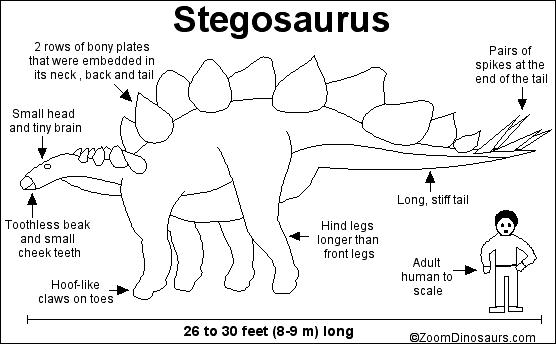
 |
| More about Stegosaurus | AllAboutDinosaurs.com Stegosaurus |
Animal Printouts |


Anatomy: Stegosaurus was up to 26-30 feet long (8-9 m) and weighed about 6,800 pounds (3100 kg), but its small brain was the size of a walnut. Its skull was long and narrow; it had a toothless beak and small cheek teeth; the head was carried close to the ground. Stegosaurus had two rows of bony plates that were embedded in its back, going from its neck to its tail. The plates ran along the Stegosaurus' back and tail in two rows, and the plates alternated in alignment. The function of the plates is uncertain; perhaps they were for temperature regulation, since they contained networks of blood vessels, or maybe they were for protection or mating display purposes. Different species of Stegosaurus had different numbers of tail spikes, ranging from 4 to 8. The spikes served as protection from predators. There were scutes (skin armor) on the neck and hip area.
Diet: Stegosaurus was an herbivore (a plant-eater) that ate low-lying plants. It must have eaten a large amount of low-calorie plant material each day to sustain itself.
Name: Stegosaurus means "covered or roof lizard." Stegosaurus was named in 1877 by Othniel C. Marsh.
Fossils: Many fossils of Stegosaurus have been found in western North America (Utah, Wyoming, and Dinosaur Ridge, Colorado), western Europe, southern India, China, and southern Africa.
| Search the Enchanted Learning website for: |